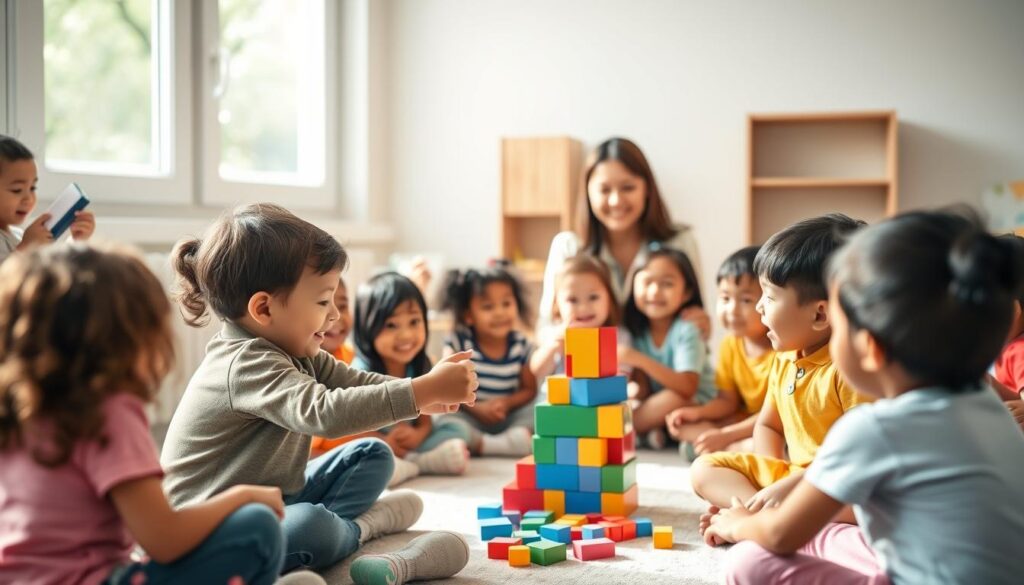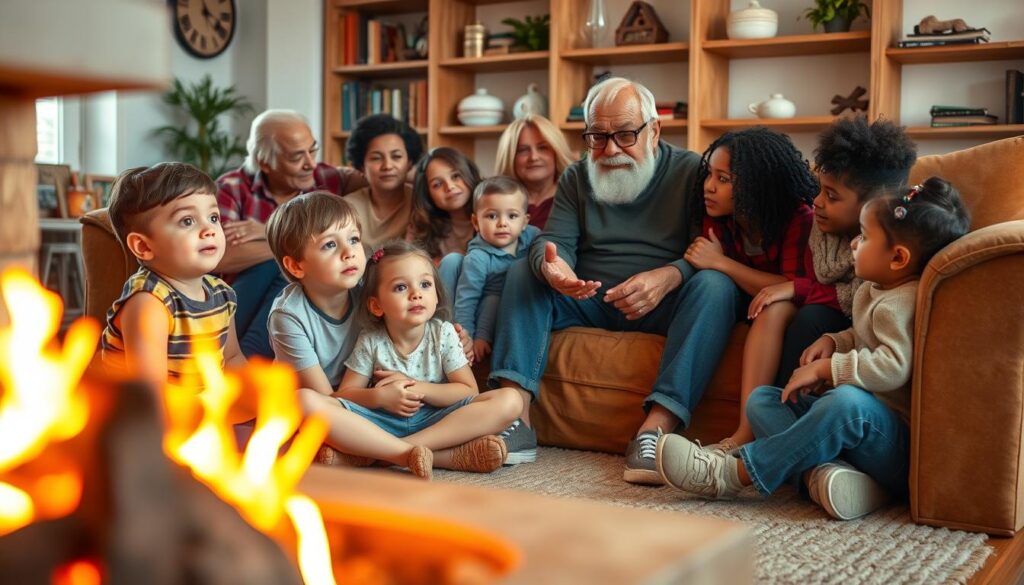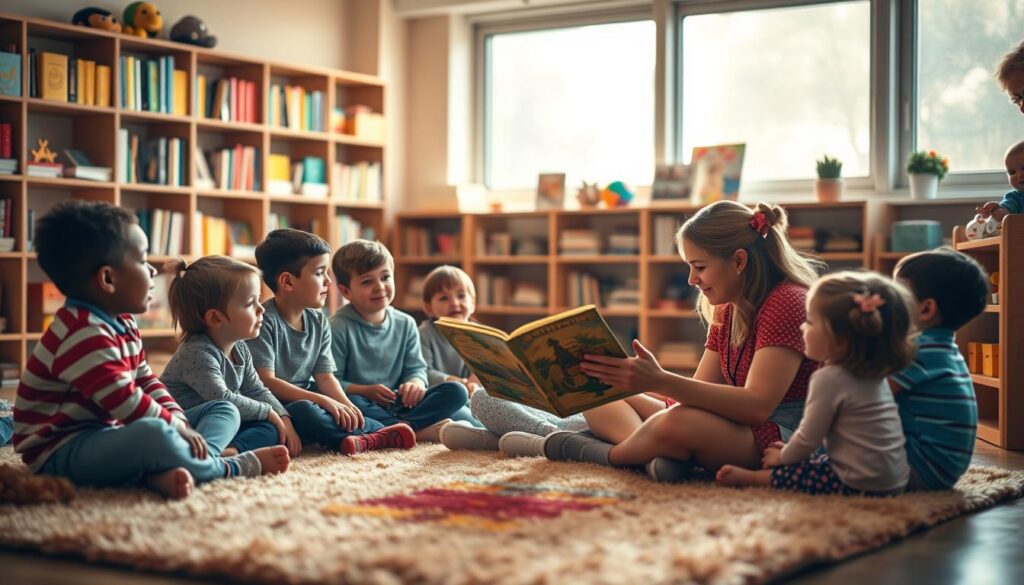Can we truly teach children to share and cooperate, or is it something they just learn on their own?
As a parent and educator, I’ve seen firsthand how storytelling can bridge the gap between understanding and practicing these essential social skills. Traditional methods often fall short, but stories have a unique way of creating emotional connections that make lessons stick.
By using cooperative storytelling, we can transform reluctant sharers into children who understand the value of working together. This approach not only teaches sharing cooperation but also fosters empathy and cooperation skills that benefit children throughout their early childhood.
The Power of Sharing and Cooperation in Child Development
Sharing and cooperation are fundamental skills that play a crucial role in shaping a child’s social and emotional development. When children learn to share and work together, they become more empathetic and understanding of others. This, in turn, helps them build strong relationships and excel in various aspects of their lives.
Why These Skills Matter in Early Childhood
In early childhood, sharing and cooperation form the foundation of healthy social development. Children who master these skills tend to perform better academically and have stronger emotional regulation. By learning to share toys and take turns, children develop crucial neural pathways that support empathy and social understanding.
| Skill | Benefits | Long-term Impact |
|---|---|---|
| Sharing | Develops empathy, understanding, and social skills | Stronger relationships, better academic performance |
| Cooperation | Enhances teamwork, communication, and problem-solving | Improved career prospects, emotional intelligence |
Long-Term Benefits for Social and Emotional Growth
The benefits of sharing and cooperation extend far beyond early childhood. Children who develop these skills tend to have better social interactions and emotional regulation throughout their lives. By fostering a culture of sharing and cooperation, we can help children grow into compassionate and successful individuals.
How Storytelling Connects with Social Skills Learning
Storytelling has emerged as a powerful tool in teaching social skills to children, fostering a deeper understanding of sharing and cooperation. As I explore the connection between storytelling and social skills learning, it becomes evident that stories have a unique ability to captivate young minds while imparting valuable lessons.
The Psychology Behind Story-Based Learning
The human brain is wired to respond to narratives, making story-based learning an effective approach to teaching social skills. Research suggests that children’s brains are literally wired to learn through narrative, activating multiple brain regions simultaneously and creating stronger neural connections than direct instruction alone. This neurological response enables children to internalize complex social concepts, such as sharing and cooperation, more effectively.
Why Stories Resonate More Than Direct Instructions
Stories have a way of resonating with children on an emotional level, making the learning process more meaningful and impactful. Unlike direct instructions, which can sometimes be met with resistance, stories allow children to arrive at moral conclusions independently. For instance, when I tell children a story about sharing, they’re not just hearing words – they’re experiencing emotions, visualizing scenarios, and making personal connections that make the learning process deeply meaningful.
| Learning Method | Effectiveness in Teaching Social Skills | Neurological Impact |
|---|---|---|
| Story-Based Learning | Highly Effective | Activates multiple brain regions, creating stronger neural connections |
| Direct Instruction | Less Effective | Limited neural connections, potential resistance |
By incorporating storytelling into the learning process, we can create a safe psychological distance that allows children to explore challenging social concepts like sharing without feeling personally criticized or defensive. For more insights on how storytelling can be used to foster creativity, visit https://lunesia.app/storytelling-and-creativity/.
Setting the Stage for Storytelling Adventures
Before we begin our storytelling journey, let’s think about how we can create a comfortable and engaging environment that encourages children to learn aboutsharingand cooperation. The physical space where we share our stories plays a significant role in how receptive children are to the experience.
Creating a Comfortable and Engaging Environment
To create an inviting atmosphere, consider setting up a dedicated storytelling area with soft cushions, good lighting, and minimal distractions. This helps children transition into a receptive mindset forlearning about sharing and cooperation. Simple environmental adjustments can dramatically improve children’s attention span and retention during sharing-focused stories. For instance, a cozy reading nook with pillows and a special storytelling chair can signal to children that “something special is about to happen.”
| Environmental Element | Impact on Children |
|---|---|
| Soft Cushions | Creates a cozy atmosphere, making children feel comfortable and relaxed. |
| Good Lighting | Helps children focus on the story and its visual elements. |
| Minimal Distractions | Reduces interruptions, allowing children to fully engage with the story. |
Gathering Essential Materials and Resources
To enhance the storytelling experience, gather essential materials such as puppets, props, and visual aids that make abstract concepts likesharingtangible for young children. These resources can help reinforce the lessons learned from the stories and provide a fun, interactive way to teachsharing cooperation. Consider creating a checklist of materials needed for each story to ensure you’re well-prepared.
By creating the right atmosphere and gathering the necessary resources, we can help children develop essential social skills through the power of storytelling. As weteach sharingand cooperation, we’re not just sharing stories – we’re shaping young minds and fostering positive relationships.
Selecting the Right Stories for Teaching Sharing and Cooperation
The stories we tell our children play a significant role in teaching them about sharing and cooperation. As a parent, selecting the right stories can help your child internalize these essential life skills more effectively.

Age-Appropriate Story Selection Guidelines
When choosing stories, it’s crucial to consider your child’s age and developmental stage. For young children, simple board books with colorful illustrations can introduce the concept of sharing in an engaging way. As children grow, more complex narratives can be used to explore the nuances of cooperation and teamwork.
Recommended Books That Focus on Sharing
Some excellent books focus on sharing, including “Sharing Time” by Elizabeth Verdick, which uses simple, rhyming text to introduce the concept to young children. “The Rainbow Fish” by Marcus Pfister is another compelling story that teaches children the value of sharing and friendship through vivid illustrations and a heartwarming message.
Stories That Highlight Cooperation and Teamwork
For stories that emphasize cooperation and teamwork, “Stone Soup” by Marcia Brown is a classic example. This folktale demonstrates how community members can come together, share their resources, and achieve a common goal. Such stories help children understand the importance of working together and the benefits it brings to individuals and communities.
By carefully selecting stories that promote sharing and cooperation, you can help your child develop essential life skills that will benefit them throughout their lives.
Effective Storytelling Techniques for Maximum Impact
Transforming ordinary stories into extraordinary learning experiences is an art that can be mastered with the right techniques. When teaching sharing and cooperation, the way you tell a story is just as important as the story itself.
Using Different Voices and Expressions
Using different voices for characters not only keeps children engaged but also helps them track the narrative and builds their sense of empathy. Your facial expressions and body language play a significant role in conveying the emotional content of the story, making it more relatable and impactful.
Incorporating Props and Visual Aids
Props and visual aids are more than just fun additions; they create concrete anchors for abstract concepts like sharing and cooperation. This makes the lessons more accessible to children with different learning styles, enhancing their understanding and retention.
Interactive Storytelling Approaches
Interactive storytelling transforms passive listeners into active participants, creating opportunities for children to practice sharing decisions within the safety of a story. Techniques like questioning encourage children to make connections between story events and their own lives, bridging the gap between fiction and real-world application.
By incorporating these techniques into your storytelling, you can create a more engaging and effective learning environment for children. This not only teaches them valuable skills like sharing and cooperation but also fosters a love for storytelling and learning.
Teaching Sharing Cooperation Storytelling: Step-by-Step Guide
Storytelling is a powerful tool for teaching sharing and cooperation to children, helping them develop essential social skills. By following a structured approach, you can maximize the impact of your storytelling sessions.
Before the Story: Setting Expectations
Before beginning the story, it’s crucial to set clear expectations and activate the children’s prior knowledge about sharing. Use specific phrases to help them understand what to listen for and how the story connects to their own experiences. For example, you might ask, “Have you ever shared a toy with a friend?”
During the Story: Highlighting Key Moments
During the storytelling, use techniques like subtle voice changes and strategic pauses to highlight key moments without interrupting the narrative flow. This helps children focus on important lessons about sharing cooperation. For instance, you can say, “Notice how the characters work together to achieve a common goal.”
After the Story: Reinforcing the Message
After the story, reinforce the sharing message through guided discussions. Ask age-appropriate questions like, “What did you learn from the story about sharing?” to help children process what they’ve learned and connect it to their own lives. For more insights on the benefits of storytelling in child development, visit Yoremi Kids.
| Phase | Objective | Techniques |
|---|---|---|
| Before the Story | Set Expectations | Activate prior knowledge, use specific phrases |
| During the Story | Highlight Key Moments | Subtle voice changes, strategic pauses |
| After the Story | Reinforce the Message | Guided discussions, age-appropriate questions |

Role-Playing and Acting Out Stories
Role-playing is a powerful tool for teaching children the value of sharing and cooperation. By acting out stories, young minds can develop essential social skills in a fun and engaging way. This approach helps bridge the gap between passive understanding and active practice.
Assigning Characters and Scenarios
When assigning characters, ensure every child feels included and important to the story’s outcome. This can be achieved by giving each child a role that contributes to the narrative, promoting a sense of teamwork and cooperation. For more insights on effective storytelling techniques, you can explore resources on storytelling and empathy.
Guiding Children Through Story Reenactments
Guiding children through story reenactments requires a balance of structure and creative freedom. This allows them to explore sharing dilemmas in a safe environment, developing emotional connections that make these skills more accessible in real-life situations.
Processing the Experience Together
After the role-play, facilitate reflective conversations to help children process their experiences. This step is crucial in reinforcing the importance of sharing and cooperation in their daily lives, fostering a sense of community among young learners.
Extending the Learning Beyond Storytime
Storytime is just the beginning; the real magic happens when we integrate the stories into our daily experiences. To make the most of your toddler’s education, consider incorporating lessons on sharing and cooperation into everyday life. This consistent reinforcement of these crucial life skills helps children understand the importance of practicing them regularly.
Connecting Stories to Real-Life Situations
To create a meaningful connection, relate the stories to your child’s daily experiences. For example, you can assign simple household tasks to your child to complete with a sibling or friend, teaching them the value of working together.
Creating Follow-Up Activities and Games
Engage your child in follow-up activities and games that reinforce the concepts of sharing and cooperation. Enroll them in extracurricular activities or sports that involve teamwork, helping them develop social skills and build friendships.
Reinforcing Lessons Throughout the Day
Discuss your child’s daily experiences with them, focusing on instances of sharing and cooperation. Listen attentively and help them understand what they can learn from those experiences. This ongoing communication ensures that they grasp the relevance of these skills in their everyday life.
- Spot “sharing moments” throughout the day and connect them back to story lessons.
- Create a sharing-friendly environment that encourages cooperation behaviors.
- Use gentle story references during conflicts to help children access story solutions.
- Gradually transfer responsibility from adult guidance to child-initiated sharing.
Addressing Common Challenges and Resistance
Navigating the complexities of teaching sharing and cooperation requires a deep understanding of child development and effective strategies. As we work with young children, we encounter various challenges that can hinder the learning process.
Overcoming Struggles with Sharing Concepts
When children struggle with sharing concepts, it’s often due to their developmental stage rather than intentional behavior. Understanding the neurological factors that influence sharing readiness is crucial. By adjusting our expectations and using incremental approaches, we can help children build confidence in sharing.
Managing Disruptions During Storytelling
Disruptions during storytelling are inevitable, but they don’t have to derail our teaching efforts. By using techniques that redirect attention while honoring children’s questions and observations, we can maintain a productive learning environment. This approach helps children stay engaged and focused on the lesson.
Adapting to Different Learning Styles
Different children have unique learning styles, requiring adapted approaches to teaching sharing and cooperation. By identifying a child’s primary learning style, we can tailor our storytelling techniques to match their needs. For highly active children, movement-based alternatives can be particularly effective.
| Learning Style | Storytelling Approach | Benefits |
|---|---|---|
| Visual | Using props and visual aids | Enhances engagement and understanding |
| Auditory | Emphasizing different voices and expressions | Improves listening skills and comprehension |
| Kinesthetic | Incorporating movement-based activities | Promotes active learning and retention |
By acknowledging and addressing these challenges, we can create a supportive environment that fosters the development of essential life skills like sharing and cooperation.
Conclusion: Nurturing Empathy Through the Power of Stories
Nurturing empathy through stories is a gift that keeps on giving, shaping children’s social interactions throughout their lives. Throughout this guide, we’ve explored how storytelling can be a powerful tool for teaching sharing and cooperation – essential life skills that form the foundation for meaningful human connections.
By connecting sharing lessons to engaging narratives, we’re not just teaching behavioral rules; we’re helping children develop empathy by experiencing different perspectives and emotional journeys. The sharing and cooperation skills your child develops through these story experiences will serve as building blocks for more complex social negotiations, teamwork, and relationships throughout their school years and beyond.
As you continue on this journey, remember that your consistent, patient guidance is the thread that weaves these story lessons into your child’s developing character. By embracing storytelling as both an educational tool and a bonding experience, you’re giving your child one of life’s most precious gifts: the ability to connect deeply with others and work together toward common goals.
FAQ
How can I help my child develop essential life skills like empathy and teamwork?
You can help your child develop these skills by engaging them in storytelling adventures that focus on sharing and cooperation. This approach not only teaches valuable lessons but also makes learning fun and interactive!
What are the benefits of using stories to teach social skills to young children?
Using stories to teach social skills helps children connect emotionally with the experiences and characters, making the lessons more relatable and memorable. This method also encourages children to reflect on their own behaviors and attitudes.
How do I choose the right stories for my child’s age and developmental stage?
To choose the right stories, consider your child’s age, interests, and current social challenges. Look for stories that feature characters and situations relevant to their lives, and that convey valuable lessons on sharing, cooperation, and empathy.
What are some effective storytelling techniques to capture my child’s attention?
To capture your child’s attention, try using different voices and expressions when reading, incorporating props and visual aids, and making the storytelling experience interactive. This will help keep your child engaged and interested in the story.
How can I reinforce the lessons from storytime in our daily life?
You can reinforce the lessons from storytime by connecting the stories to real-life situations, creating follow-up activities and games, and consistently referencing the stories and their lessons throughout the day.
What if my child resists or struggles with the concepts of sharing and cooperation?
If your child struggles with these concepts, try adapting your approach to their learning style, and be patient and consistent in your efforts. You can also try different stories and activities that may resonate better with your child.




